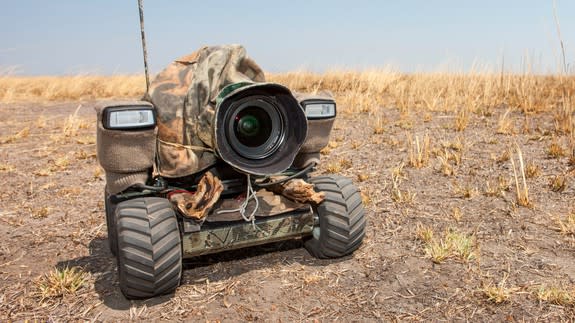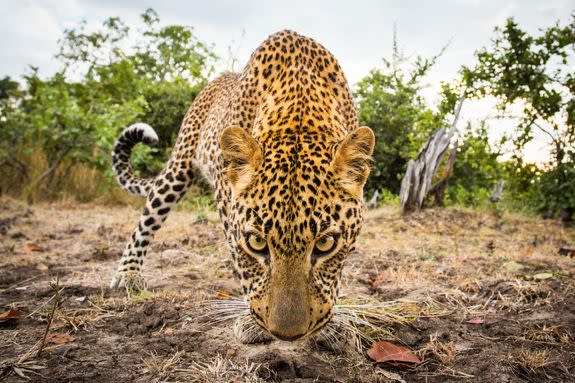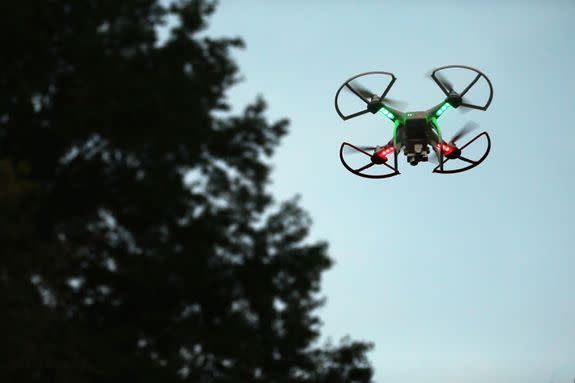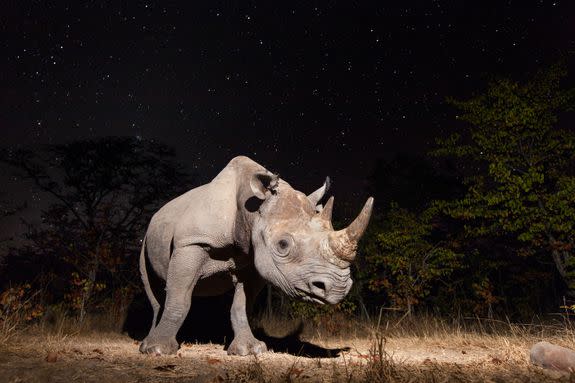These robots are transforming how we see wildlife

Wildlife photographer Will Burrard-Lucas had long wanted to add up-close-and-personal images of iconic African animals to his portfolio. But to get those intimate shot of lions and leopards, he would need to crawl up right next to their sharp-toothed faces.
So Burrard-Lucas devised a far less deadly alternative.
SEE ALSO: The world's fastest land animal is even more threatened than we thought
In 2009, during a trip to Tanzania and Kenya, he bolted a camera to a small remote-controlled, four-wheel buggy and steered the rig toward herds of elephants and rambunctious lions. His BeetleCam, now on its fifth edition, has since evolved to include new features like a remotely-operated camera tilt and a live video feed.
"It's closer to how you experience the world with your own eyes," the U.K.-based photographer told Mashable. "It's almost like when you see the pictures, you're there."
Robots small and large — from the backpack-sized BeetleCam to multimillion-dollar underwater vehicles — have given photographers and scientists an unprecedented look into the world of endangered animals, rare species and deep-sea creatures.

Image: will burrard-lucas
These devices can go where humans typically can't, be it nuzzling noses with leopards, roaming the seafloor for days at a time or sidling up next to super elusive sperm whales. And they do far more than capture mesmerizing photos and breathtaking videos.
Ready for their undersea close-ups
With remotely operated technologies, researchers can take more accurate population counts of extremely threatened species, or better document the effects of climate change and land development on animals' habitats. Submersible robots have enabled scientists to discover hundreds of previously unknown underwater species.

Image: will burrard-lucas

Image: will burrard-lucas
Ocean Exploration Trust, a nonprofit dedicated to exploring the ocean, uses two remotely operated vehicles (ROVs) to do everything from mapping the seafloor and measuring methane bubbles to exploring radioactive shipwrecks off the California coast.
The nonprofit's first vehicle, ROV Argus, can dive down to 6,000 meters, and is often used to stabilize and illuminate ROV Hercules, which sports six thrusters that allow it to "fly" in any direction underwater. Hercules' two manipulator arms let the ROV gather underwater samples and recover artifacts, while its high-definition camera streams live video to the controllers aboard the Exploration Vessel Nautilus.
"Sending people to the bottom [of the ocean] is very dangerous and expensive, and it's very complicated. The conditions have to be exactly right," Susan Poulton, a spokesperson for Ocean Exploration Trust, told Mashable.
"We've kept vehicles submerged for over three straight days on a dive site," she said. "In places that are too dangerous to navigate with a manned submersible, we can navigate with an unmanned ROV."
By staying underwater for longer stretches, the Nautilus crew has a far greater chance of encountering spectacular wildlife.
Poulton recalled a 2015 expedition in the Gulf of Mexico when a sperm whale approached the ROVs while scientists were tracking a methane bubble.
"It checked us out for 20 minutes, and we could witness his behavior and how he explored us," she said. "We had this unbelievable experience."
The Schmidt Ocean Institute, a private foundation, also works with remotely operated technologies to advance marine research.
Its ROV SuBastian (named after the main character in the movie The NeverEnding Story), which the institute recently tested off the coast of Guam, will be able to support high-resolution seafloor mapping and gather samples of rocks, animals and seawater, among other abilities.
Flying high in the sky
The organization also supported the early development of long-endurance "unmanned airborne systems" — aka drones — to gather atmospheric data in the Arctic, which will help oceanographers better understand how sea ice breaks up and melts in the era of human-driven climate change.
In the much balmier climate of Belize, conservationists are flying different types of drones to aid their fight against illegal fishing.
The Wildlife Conservation Society, working with the Belize Fisheries Department, is using quadcopters to monitor the mangrove keys and tiny inlets where fishermen and poachers often hide their illicit catches of lobsters, conchs, sharks and regulated fish species.
"Sometimes from a vessel it's hard to spot those inlets, and fishers can hide," said Julio Maaz, the conservation group's technical coordinator for sustainable fisheries in Belize.
"We also felt that drones could assist us in reducing the amount of fuel used to do patrols in ships," he told Mashable.
Other organizations in Belize have adopted drones to help track and count manatee populations and to monitor wildfires — a task that otherwise requires researchers to traverse the jungle on foot to determine the extent of fire damage.

Image: bruce bennett/Getty Images
Burrard-Lucas, the wildlife photographer, said he has expanded his remotely operated set-ups to include "camera traps."
Equipped with infrared triggers, the traps can sit in the field for days or weeks. When a nocturnal or elusive animal crosses the infrared sensor, the DSLR camera snaps images that would otherwise be impossible for photographers to capture in the flesh.
Through his company Camtraptions, Burrard-Lucas sells two versions of the trap. Researchers with groups like World Wildlife Fund tend to favor the smaller, inexpensive systems, which take grainy images but help document the movements of animals and gather head counts.
The more costly version takes higher-quality shots, including Burrard-Lucas' personal favorite: A skittish rhinoceros under a clear, starry sky.

Image: will burrard-lucas
"It couldn't be achieved using anything other than a remote camera or trap," he said.
Burrard-Lucas said he plans to take his camera trap and BeetleCam systems to Africa's rainforest regions this year to photograph lesser-known, forest dwelling species. He will also keep developing new iterations of his designs.
"It's a never-ending cycle," he said of the technology.
Video credits: Ocean Exploration Trust (sperm whale); Schmidt Ocean Institute (Mariana Volcanic Arc).
Watch robots in VR
Introducing The Possible, a new virtual reality series that explores groundbreaking technology.
Click here to download the Within app and watch The Possible.

